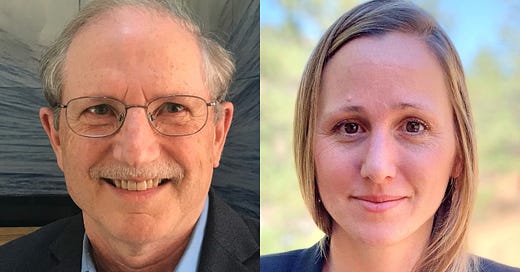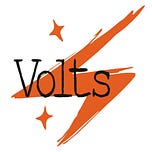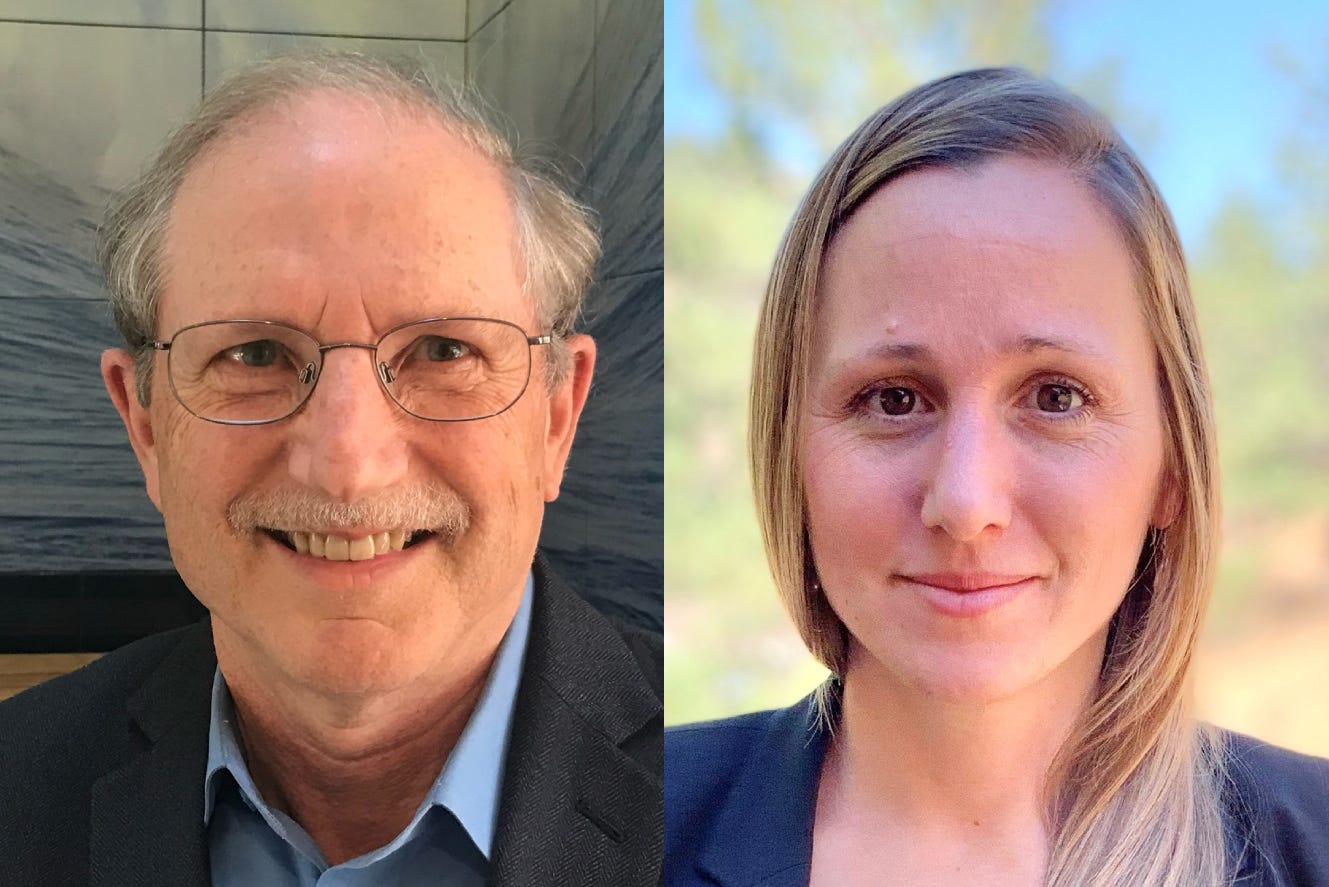After decades of talk about offshore wind, California seems closer than ever to actually supporting an industry. But to meet the state’s goal of five gigawatts of offshore wind power by 2030, a lot of as-yet-nascent pieces need to fall into place. In this episode, Adam Stern of Offshore Wind California and Jocelyn Brown-Saracino of the US Department of Energy discuss California's recent policy efforts and the state of floating-wind technology.
Text transcript:
David Roberts
The offshore wind industry is finally up and running in the Northeast US (though it has hit a few, er, speed bumps). What about the West Coast, though? There’s a lot of coast out there!
There’s been talk about offshore wind in California for decades, but the last few years have seen a flurry of activity that almost makes it possible to believe it could actually happen. Virtually all of the state’s big players — the legislature, the California Energy Commission, the state's public utility commission, and the state's grid operator — have put forward planning or goals or funding or some kind of support for offshore wind.
To meet the 2030 goal the state has set itself (5 gigawatts), lots of very big, very difficult things will have to come together just right, everything from grid infrastructure to a domestic manufacturing supply chain to a domestic work force to a mature, standardized floating-wind technology. None of those things exist yet; they will all have to grow rapidly at once. It’s daunting.
To discuss the state of play in both policy and technology, I’m talking to Adam Stern, head of the industry coalition Offshore Wind California, and Jocelyn Brown-Saracino, the offshore wind lead at the US Department of Energy. We’ll get into everything California is doing to spin up an industry and the current state of floating wind turbines, which will be needed in the deep West Coast waters.
All right, then, with no further ado, Adam Stern and Jocelyn Brown-Saracino. Welcome to Volts. Thank you so much for coming.
Adam Stern
Nice to be on the program, David.
Jocelyn Brown-Saracino
Yeah, pleasure to be here.
David Roberts
I'm excited to dig into this. I've been wondering about this subject for ages. Like many things I wonder about for ages, it seems like all of a sudden everything is happening. So, we're going to cover that today. Adam, I want to start with you. Let's start with just a little bit of history here. I know I have followed the East Coast offshore wind saga somewhat closely. It's been going on for a long time. It's hard to say they're ahead of California since they barely actually built anything. But there are actually a few operative turbines off East Coast waters now.
So, give us a little history of the discussion of offshore wind on the West Coast. Why is it so far behind the East Coast, and what has happened and what has brought us to where we are today?
Adam Stern
Sure, David. That's a great question. So, the context is, beginning in 2016, the state of California, through its agencies like the California Energy Commission, the California Public Utilities Commission, and other players, started discussions with the Federal Bureau of Ocean Energy Management. That's an agency that's part of the US Department of the Interior, which has jurisdiction over sea space off the coast for the development of offshore wind. Those discussions eventually led to a lease auction in December of 2022, where the federal government put out five wind energy areas 20 to 30 miles offshore of California's coast and awarded eventually — after the bidding results were in — leases to five companies to begin the process of planning offshore wind farms.
That's how we get to the lease auction and the leaseholders.
David Roberts
Yeah, I just wonder, like, is there a story to tell about why it took so long for them to get here? The idea of offshore wind is very old. Like, offshore wind industry is very old. Is it just waiting on the technology of floating turbines, was that the holdup? Or is there a story to tell about why they didn't start sooner?
Adam Stern
Yeah, I think it's a combination of waiting for the technology to develop. The other dimension was California was very successfully pursuing other types of renewables, utility-scale solar, onshore wind, battery development, all of which they were leading on. And so the focus was there. Offshore wind was another resource. It took more time to understand, also to do a significant amount of stakeholder engagement, because there are a lot of parties that need to be involved in planning like this. I think at the same time, on the East Coast, and Jocelyn can speak to this, the East Coast states had less options.
They didn't have the solar; they didn't have the transmission infrastructure. And so, offshore wind was the thing. And that probably explains at least part of why California has taken longer.
David Roberts
Yeah, and California, of course, now having installed all those variable renewable resources, more than ever needs clean firm resources. That is, resources that produce when the sun's down, which, of course, offshore wind does. So, like, the value of clean firm resources is rising in California. So that's probably part of it, too. So they sold some leases finally in 2022, and that's kind of the starting gun. And I think sort of like one of the themes of this pod is going to be, I want you to help overcome my skepticism, because California has this goal — so let's talk about this first, the establishment of the goal.
So, the California Energy Commission just recently adopted a plan. Tell us a little bit about that plan and the goals contained therein.
Adam Stern
So, the plan was part of legislation that was passed by the legislature in California in 2021. The first deliverable was setting planning goals for offshore wind. And those came in at two to five gigawatts by 2030 and a nation-leading 25 gigawatts by 2045. Then, the state, through all of its different agencies that have jurisdiction over this kind of planning, worked for two years to develop a strategic plan defining basically a roadmap for how this was all kind of going to happen. And it covered a host of issues — that I'm sure we'll get into in the pod — about port development, transmission planning, procurement, sea space planning, supply chain.
There are many dimensions to this that need to be working in unison. The plan that came out and was adopted just a few weeks ago, in July of 2024, is probably the most comprehensive floating offshore wind plan in the world. It was worth the wait because it lays out in each of these subject areas what needs to happen to make offshore wind real.
David Roberts
So, you were happy with the plan. You felt like they really got their arms around it.
Adam Stern
It's an excellent product. It was tested with lots of audiences through public workshops. There was a high level of engagement with environmental groups, with labor unions, with tribal organizations. There were drafts and redrafts. And ultimately, I think it's an excellent plan.
David Roberts
Okay, so it's got these five gigawatts, up to five gigawatts by 2030 and 25 gigawatts by 2045. Those are very aggressive goals. And part of what we're going to discuss today is all the things that have to be happening simultaneously and being pulled off pretty perfectly to come together to get, like, steel in the water to hit those targets. Like, if they pull this off, it will be incredibly impressive. So among the things that California needs to do, let's start talking about them. So one is transmission. CAISO, the transmission operator in California, has a plan for that, too.
Tell us a little bit about that piece of the thing, because if you're going to be bringing a lot of power to shore, you need the grid infrastructure to accept it.
Adam Stern
That's exactly right. And in May of this year, the CAISO approved its 2023-2024 transmission plan. Included in that is $4.6 billion in offshore wind-related transmission upgrades, specifically for the north coast of California, several hundred miles north of San Francisco, where some of the biggest wind energy areas exist. That was a very significant development to have this level of planned investment in their plan. And secondly, they also have done analysis about transmission to the central coast areas south of San Francisco, a couple of hundred miles, where CAISO now estimates that between five and six gigawatts of transmission capacity already exists from a retired natural gas plant.
And also, the planned phase-out of the Diablo Canyon nuclear power plant around 2030. So, those two directions are central to the transmission planning for the state. And the CAISO plan shows acknowledgment and action so that transmission for offshore wind will be ready when the power is ready.
David Roberts
But, Adam, I'm sure you have followed in the past couple of years, obviously, the transmission discussions have really kicked up. Of course, one of the main things people talk about is how difficult it is to actually do it and how many choke points and breakpoints there are, and how many actors there are that have to be persuaded, and how many NIMBYs there are that have to be overcome, et cetera, et cetera, et cetera. How confident are you that CAISO is laying out this plan that it's really going to happen? You know what I mean? Is California transmission subject to all those same blockers and challenges?
Adam Stern
You're right, David. There are a lot of reasons to be concerned. They've also been, though, some improvements in the permitting process that California has begun to work on, which hopefully will expedite the development of mission-critical transmission for bringing renewable power online, including offshore wind.
David Roberts
Yeah, we'll see if they can pull that off. One of the things that's in the California Energy Commission plan, they say — and this seems obvious in retrospect, but I guess it's not something that I knew going in. They make the pretty obvious point that it's not going to be one or two ports involved in this. If you're going to make this work, you're going to need a lot of ports in terms of building equipment, shipping things in and out, et cetera, et cetera, dealing with the supply chain. So, the California Energy Commission says it will need 26 ports involved in this.
And so, there's a federal grant. Tell me about the federal grant. How's that going to start the port process?
Adam Stern
So, the federal grant is for the Port of Humboldt, which is in the far north of California, 300 miles north of San Francisco. They received in January a $427 million federal grant. It's actually part of the Bipartisan Infrastructure Law to build an offshore wind marine terminal. Now, that is not the full amount required to do this. The grant requires a match from either state or private sources, which haven't been identified yet, but it is a major down payment and a signal of support which has been embraced by the harbor district in Humboldt. And it's really the jumpstart that was needed to get the planning underway.
David Roberts
So, we don't know where the rest of the money is coming from yet. Presumably, California will have to come up with the rest of that money somewhere?
Adam Stern
Most likely, a significant part of it, but it also could come from some private sources.
David Roberts
When you say offshore wind terminal, what should we be sort of envisioning there? What is that exactly?
Adam Stern
It's a staging and integration terminal that is basically the place where all the components, the towers, the blades, the cables, come together and are put together like a giant Lego set to create individual offshore wind turbines that then are tugged by tugboats out to sea, 20 to 30 miles off the coast. And that's basically the logistics of all of this. I was going to say, in addition, the Port of Long Beach in Southern California, near Los Angeles, has also stepped forward with plans for a similar staging and integration terminal for offshore wind. They're not quite as far along, but they've begun the environmental scoping process, and they have stepped forward with very ambitious plans, and they're starting to organize all the elements that will be needed to approve that plan.
So, at the end of this process, we've got, I mean, in this early stage, two flagship ports identified, one in the far north, one in the south, that are getting themselves organized to do this important work.
David Roberts
Yeah, well, I come back again to like the CEC, the California Energy Commission, says there's going to be 26 ports involved in this. I'm guessing that it doesn't mean 26 of these sort of full-fledged marine terminals? Surely not, because if they all cost a billion dollars or so, 26 of them is $26 billion, and I really don't know where that money would come from. So, how should we think about the idea of completing enough ports to actually support this industry? It just sounds incredibly expensive. Am I blowing it up in my mind too much?
Adam Stern
So, there are other categories of ports that are important to the whole puzzle. There's manufacturing and fabrication ports, and there are also maintenance and operations ports. These are generally smaller developments, but they all play key roles. Now that the state has come out with this plan, many of the ports are showing up to figure out what their role in this ecosystem of port planning is. It remains to be seen exactly how the puzzle will look. But the fact that the two staging and integration ports, which have the biggest amount of space available and the commitment from their local authorities to move forward with the planning, is very significant.
The other ports are getting themselves organized and figuring out what role they can play. And the strategic plan that we've spoken about actually lays out in some detail a kind of inventory of California ports and what roles each one is best suited for.
David Roberts
Right, and so, where's all that money going to come from? Like, that's a lot of money. Do you think California's going to scrape it together with some private — I know, actually, there's a ballot measure coming up on the current ballot. Tell us a little bit about that.
Adam Stern
Yeah, so just a month ago in early July, the California legislature set up and passed a climate bond which covers a variety of environmental objectives, including clean drinking water, wildfire protection, park development, resilience to different climate change impacts. Embedded in that is a very important feature, which is $475 million for port infrastructure for offshore wind. This would be another significant payment if the voters approve this in November, a significant payment towards this larger capital investment that's required to get the ports ready for developing offshore wind.
David Roberts
So, how do you... I'm not even totally sure how to ask this question, but you need a domestic supply chain, I'm assuming. The things we're talking about are so big, this is not going to be the kind of thing that you can import from other places. Most of this is going to have to be done domestically. So, if I'm trying to persuade someone to start a private company devoted to making some part of offshore wind turbines or some part of that, there's not really the infrastructure or the market in place yet. We're sort of promising the private industry, "Develop this industry, and we promise by the time you're ready, we'll have some ports in place, we'll have some money ready."
Like, how do you get an industry going when there's not an industry yet, if that makes sense?
Adam Stern
Very good question. And there's another important development that just happened in the middle of July that speaks to this, which has to do with procurement. The California Public Utilities Commission issued a proposed decision using a new central procurement mechanism, which was developed and passed by the California legislature a year ago for what are called "long lead time resources," one of which is offshore wind. The others include enhanced geothermal and long duration battery storage. But basically, these are for clean energy resources that can't be easily developed and require a lot of planning and advance investment. The significant thing that came out of this proposed decision was that the CPUC issued a determination of need, 7.6 gigawatts of offshore wind in 2035.
Now, that's not as big as the ten gigawatts that our organization and several other advocates promoted, but it's still a very big number. And in addition, the CPUC set up a solicitation schedule for offshore wind power, with the first one beginning in 2027. Qualified bidders are going to be able to submit bids for this power to the CPUC and, if accepted, develop power purchase agreements. Collectively, the things that I just described are the market signal that people in the industry have been waiting for, because it gives a sightline to when this is actually going to happen. Solicitation of bids for the power in 2027. Delivery of power in 2035.
David Roberts
So, just to be clear about that, that is the CPUC saying, "California will buy 7.6 gigawatts of offshore wind. We're setting aside money to buy this." So, that just says that there's a customer here.
Adam Stern
Exactly. It's an offtake customer. And the costs and associated benefits of this will be spread across the load-serving entities, the investor-owned utilities, and the community choice aggregator agencies. All of those utilities will be expected to share their part or basically pay for their part of this central procurement buy.
David Roberts
Interesting. And we think that, like saying at this early stage, "We here stand ready to buy 7.6 gigawatts of power." That's a big enough sort of market signal to kick private industry into action, you think? I mean, I guess we don't know yet, but do you think?
Adam Stern
Exactly. And we're already seeing signs, David, of the supply chain starting to respond to this. There have been a number of announcements since this of planning agreements for other ports. There's talk of other elements of this symphony that we have to get organized on schedule. Seeing this decision and saying, "Oh wow, California is really serious about this. They've set a date for a bidding solicitation and a delivery date. Now we can begin to envision how this market delivers and all the other elements that have to be ready for this." And if I'm a manufacturer of turbine blades or cables, I'm now treating this opportunity much more seriously than I was before.
David Roberts
You know, some of these things, some of these pieces of the supply chain, these are like, these are multi-million dollar, billion-dollar industries, multi-million dollar, billion-dollar investments. I guess if I was an investor, would I invest a billion dollars on the promise of the California government? I guess I don't know if I would or not, but it's not obvious to me that that in and of itself is like rock solid enough to de-risk these sort of enormous investments. I guess we'll find out in coming years, but —
Adam Stern
Yeah, but you look at the history on this. California knows how to lead on renewable energy. It's done it with solar when they first started talking about the million solar roof law. People said, "That can't be done. That's not possible." Now we have over a million and a half solar roofs. They've done it on electric vehicles, where they set goals for adoption. In the last quarter, 25% of the cars sold in California are zero-emission vehicles. And now it's happening with batteries, where batteries are now the fastest-growing part of the renewable portfolio that California has for its grid.
So, California has done this. I don't want to sugarcoat this, David. This is an extremely complicated, multifaceted enterprise with many different things that have to be working in unison. But these steps on ports, transmission, and procurement, just to name three, these are big signals, and I think you're going to see more commitments by some of the other supply chain players. Our trade organization represents 35 companies that are part of the offshore wind ecosystem. And, you know, they are looking at this decision and playing out its implications. And many of them have interests and capabilities that I think they'll be engaging more directly with the state in now.
David Roberts
Sure. Let me raise just a couple of points of skepticism for you to address. One is the slowness thing. So, I think a lot of people, when they hear California has a big scheme for a giant infrastructure project, the first place their mind goes is high-speed rail. And that is not a happy template. You know, we've seen high-speed rail go from these massive plans and big talk and sort of shrinking down and down and down, spending more and more and more. And now, they're releasing press releases bragging about how much money they've spent and how many people they've employed, and they haven't built anything.
So, a lot of people are sort of like, "This is classic blue state bureaucracy here." There's all these permitting issues, there's all these environmental review issues that always go on. California is notorious, the California energy law, notorious for this. Environmental reviews go on forever. So, how do we, why should we have confidence that in terms of just the bureaucracy permitting, overcoming local objections, you know, staying on budget — like, high speed rail does not inspire. Are you confident that the sort of permitting side and the kind of social license side is capable of speed?
Adam Stern
Totally fair question. There's a very extensive permitting chapter in the strategic plan that lays out all the different state and federal agencies that have to issue permits. There is supplemental legislation that has been passed to help expedite aspects of the permitting process. So, there's an awareness that this is going to take extraordinary coordination and planning, but at the same time, there's a very high level of enthusiasm among stakeholders, environmental groups which haven't had the best track record of endorsing or supporting —
David Roberts
Let's talk about that. Like, what is the general — you know, because environmental groups, to their, I think, discredit often in California, are often, as you say, agents of slowing things down. They've slowed down building in cities. They object to transmission lines, et cetera, et cetera. And I just imagine when we're talking about oceans... So, what is the general disposition of the big environmental groups toward this industry?
Adam Stern
What I've seen, David, from many of the public meetings that I've attended over the last five years, is there is a lot of excitement and interest about this. There is a legitimate concern about ensuring that this is done in a responsible way that protects California's coastal legacy, heritage, and resources, protects fisheries, tribal interests. And many of the mainstream environmental groups are involved and supportive, with caveats that it needs to be done thoughtfully and responsibly. And I've heard from, just to name one example, the National Audubon Society's clean energy program has said, "If we don't embrace something like this that has the potential to deliver clean energy for millions of Californians, the species of birds and other marine life that we're focused on protecting won't have a home."
This is our opportunity to do it responsibly and thoughtfully. And we're all in, in trying to design this in a safe and environmentally attentive way.
David Roberts
The other sort of problematic factor, beyond the sort of bureaucracy and delays that are typical of West Coast states, is just the money. So in particular, California electricity rates have been going up and up and up and up and up. This is not contrary to a lot of public opinion, not because of renewables. It's generally the delivery side. It's generally the transmission and distribution side that's driving costs up. But nonetheless, California consumers are paying more and more and more for electricity. It's becoming a real political problem. It's something that these regulatory bodies are extremely gripped by at the moment.
So, I guess I'm wondering, you need to pay for these ports, you need to pay for this new transmission infrastructure. You're probably going to have to pay, I think, pretty elevated rates for the first tranche of power that comes out of these things, just because there'll be lots of first-of-a-kind things going on here. So the whole thing, like, you can envision a steady state 50 years out where all this has paid for itself and everybody's happy they did it. But between here and there, there's a lot of spending money at a time when California ratepayers are particularly sensitive to paying more money.
Like, how do you think about that dilemma?
Adam Stern
Yeah, so it all has to do with economies of scale and setting out a large enough vision, which I think the state of California has now done to help reduce the costs. The bigger the planning goals — the record of offshore wind in other parts of the world, in Europe and in the early stages on the East Coast of the US, shows that bigger ambition leads to lower costs. By issuing the 7.6 gigawatt needs assessment for the procurement in California, that's a big signal. And I think when there are additional procurement commitments or planning goals and the supply chain starts to assemble, you're going to be able to track a path to affordable rates for offshore wind.
And in fact, the CPUC's proposed decision specifically says that unless California invests in offshore wind now, it won't be available in the 2040s, when we absolutely need it to help meet our 100% renewable goals. So they're saying that there's a rationale for doing this that actually will lead to lower rates for consumers. And to me, that's one of the more exciting elements of this proposed decision from the CPUC.
David Roberts
Well, I mean, there are lots of places in public policy where spending more now will save money later, but that doesn't make it any easier to pitch to the people paying.
Adam Stern
There's a whole jobs and economic development element of offshore wind. There are studies that these different planning agencies have issued that shows thousands of family wage jobs in many different high-skilled professions. There's another benefit to this that I think is rather unique: to start an entirely new industry. And California is using its size as the fifth largest economy in the world to start a whole floating offshore wind industry.
David Roberts
Is the idea that the whole supply chain will basically be in California? I mean, is the idea that, like, all of this is going to be built from the ground up in California?
Adam Stern
That's the objective. I think the people who are planning this have not had a chance yet to fully lay out how much is going to come from local sources and how much from, you know, imports. But I can tell you that the leading unions in California have been engaged in all of these planning meetings. They've been showing up in force at workshops, and they're making it clear that they want the jobs associated with this. And our organization and many others are delighted to have them as full partners in this planning so that the great majority of this work can be done here in California.
David Roberts
Interesting. Okay, I want to turn to Jocelyn and talk about some tech stuff, but just one final question, Adam, I have to ask you. If you are held at gunpoint and forced to make a prediction, when do you think there will be a commercial power-producing offshore wind farm operating off the coast of California?
Adam Stern
I think it's very possible in the early 2030s. I'll just tell you, as I've been explaining this to my mother for many years. She said, "How many years do I have to still keep living so that I'll see this and be able to celebrate this?" And that's what I've told her. Early 2030s.
David Roberts
Early 2030s. All right, well, we'll hold you to that. Okay, Jocelyn, are you there? Are you with us?
Jocelyn Brown-Saracino
I am.
David Roberts
So, let's talk tech. All the stuff I just talked to Adam about would be difficult to pull off, even if there were a robust, settled offshore wind technology that they were all organizing around. But there is, to my understanding, not such a thing. So, you're part of a team at DOE trying to make that happen. So, tell me just a little bit about the Earthshot. I think Volts' listeners will remember the solar shot that DOE did to drive down solar costs, and that worked so well that they've sort of spun that model off now.
And there are shots going all over the place now. There's a geothermal shot and a shot here and there, but you are leading the offshore wind shot. So, just tell us a little bit about that program and what its goals are.
Jocelyn Brown-Saracino
Yeah, absolutely. Happy to do so. So, the floating offshore wind shot is one of a series of DOE's Energy Earthshot initiatives, as you said, modeled after the SunShot initiative. And really, these are intended to be initiatives that tackle some of the challenges that remain, that provide the greatest opportunity to address our climate challenge. The floating offshore wind shot is an initiative that's seeking to advance US leadership in floating offshore wind design, manufacturing, and deployment, both with a lens of contributing to decarbonization, but also with an eye to trying to revitalize coastal economies. Floating offshore wind is a partnership — one of the things that's powerful, I think, about the floating offshore wind shot is that it is a partnership between not just the Department of Energy, but also the Departments of Interior, Department of Commerce, and also the Department of Transportation. And through that partnership, given the complexity of the work that remains before us, we're really seeking to leverage the capabilities and authorities and resources that span the gamut of issues that you and Adam were talking about to really try to bring to bear federal resources in this area.
David Roberts
And so, every shot has its headline dollar amount that it's targeting. What is yours?
Jocelyn Brown-Saracino
So, as you said, each of the shots comes with a very ambitious goal with respect to reducing the cost of energy. The floating offshore wind shot sets out a very ambitious goal of lowering the levelized cost of energy for floating offshore wind by more than 70% by 2035. One of the things that we're keen to emphasize when we talk about this is that it is not a business as usual target. That is a target that's meant to represent what might be possible with an aspirational effort. And, you know, as you and Adam were discussing, part of what will make these sorts of cost reductions possible in the future is the scale of development and addressing the infrastructure needs associated with that scaling.
David Roberts
So, the shot here is to reduce costs by 70% to something around $45 per megawatt hour by 2035. And so, just to give the audience a little context, right now, straight up utility scale solar is in the, I think, twenties. That's roughly comparable now to the cost of power from solar plus storage right now, just to give audiences a ballpark. But it's worth adding, as I think Adam and I mentioned, that the levelized cost of energy can be deceiving. There is extra value to being firm power, so that $45 per megawatt hour maybe doesn't carry all the information.
But anyway, one of my main questions is, "Reduce costs 70% from what?" Like, there is no, like, is there an offshore wind? I mean, not offshore. I mean, floating specifically, are there floating offshore wind turbines operating somewhere?
Jocelyn Brown-Saracino
Yes, and it's a really exciting moment for floating offshore wind, because we consider the industry at this moment to really be at an inflection point. So, just to level set for listeners, floating offshore wind enables access to offshore wind resources in deeper waters that aren't accessible by the traditional fixed-bottom type of offshore wind technology that we've seen deployed around the world to date. To date, we have just over 230 installed floating offshore wind.
David Roberts
Where is it?
Jocelyn Brown-Saracino
So, that's in a combination of countries in Europe and Asia, but that's about 0.3% of deployed offshore wind globally.
So, the vast, vast majority of offshore wind deployed to date around the world is still this fixed bottom technology. But one of the reasons why this is such an exciting moment for floating offshore wind right now is that when we look at the global pipeline of offshore wind at various stages of development, the floating offshore wind pipeline is greater than 100 gigawatts, and it's close to 25% of the global pipeline.
David Roberts
Global offshore wind pipeline?
Jocelyn Brown-Saracino
Writ large, and so we are really seeing a pivot point in offshore wind development, where the future of offshore wind, we anticipate, is going to include increasing amounts of floating offshore wind development, simply because it allows us to access so much of the global wind resource, about 80% of the global offshore wind resources in those deeper waters. That would require floating offshore wind technology development.
David Roberts
I have so many questions, but that was one of them. So, you mentioned this, but just to clarify, off the East Coast, where they're building turbines now, is a pretty shallow continental shelf. So, the water is pretty shallow. So, it's pretty easy up there to build standard offshore wind turbines where there's a big fixed concrete base on the floor of the ocean. But then, once you drop off that continental shelf and get deep, it's just impractical to build a big foundation on the bottom. The bottom's too far away. So, you have to float. You have to figure out stability.
Floating. But just in the US context, going from shallow to deep gets you a bunch more on the East Coast and then opens up the whole West Coast. Like, the entire West Coast is basically deep, is that right?
Jocelyn Brown-Saracino
Yeah, that's absolutely right. So, when we look at our technical resource potential for offshore wind in the United States, about two-thirds of that is in those deeper waters that would require floating offshore wind technology. And as you said, that's true for virtually the entirety of the Pacific coast. It's true for the Gulf of Maine, and it's also true for Hawaii. But then, the floating offshore wind also provides the opportunity to expand offshore wind deployment further offshore, even in areas like areas of New England and the Mid-Atlantic, where we're seeing fixed bottom development.
David Roberts
Right. So, just an enormous new resource, basically, that we're sort of in the midst of tapping basically for the first time. This is all pretty nascent. I'm so curious about the technology here. You say there are floating turbines operating now. To what extent is there a standard design now? Or are we still in a stage of things where there are multiple live possibilities for how you build this thing?
Jocelyn Brown-Saracino
So, we have seen, as I mentioned, a number of projects deployed around the world. These are in pilot and a kind of pre-commercial scale stages of development. When it comes to the technology itself, most of the projects that have been deployed to date utilize the commercial off-the-shelf turbine technology that's being used by the suite of fixed bottom projects that we've seen deployed around the world to date. But of course, and importantly, for those to be floating, those turbines then need to be mounted to a floating substructure that is then anchored and moored to the seabed.
And currently, right now, there are primarily four different types of platform designs that folks are considering, that all differ with respect to how they get their source of stability. Then, there are also a number of hybrid concepts that combine some of the attributes of those different concepts. We do anticipate over time that there will be some design coalescence. It may not be around a single design type because developers are going to be optimizing for different design conditions. As I mentioned, there are different advantages and drawbacks to the different designs. But we do think that we're going to go from a system right now where we have dozens of different designs to one where there are a few leaders with respect to floating platform design.
David Roberts
What you're making it sound like is you basically just pluck the turbine, a standard offshore wind turbine, and just put it basically on a different kind of platform, a platform that's floating instead of fixed to the bottom. Because I feel like I saw — you're constantly seeing on the Internet these wacky designs for new kinds of wind turbines, and I'm never sure how seriously to take them — but I saw one that was very intriguing for offshore, floating, where the turbine itself is sort of almost laying kind of flat in normal when there's no wind. And it's sort of like the wind pushes it upright when there's wind, and this enables it to survive storms and stuff like that more.
Is all that stuff just kind of Sci-Fi are we just going to settle on the standard turbine design, or are the actual towers and turbines themselves, do you think eventually might also get tweaked?
Jocelyn Brown-Saracino
So, when I mentioned the use of existing commercial, off-the-shelf turbines, that's really around the projects that have been deployed to date. I think that there's active dialogue happening in R&D with respect to whether we move to more bespoke designs for certain technologies in the future or not. And one of the areas of active research in the floating offshore wind space is the idea of systems engineering and thinking about how do we design offshore wind systems from a systems perspective. So, thinking about how we optimize both the controls as well as the hardware itself, as a system from seabed all the way up to blade tip.
Adam Stern
A group of us from California in February went to see one of the pilot projects that Jocelyn referred to. This is the Kincardine floating offshore wind farm off Scotland. And it's remarkable. It's only five turbines, but it generates roughly 50 megawatts of power. And today, it's delivering clean power to 30,000 Scottish homes. So, this isn't science fiction. It's not utility scale yet, but there are examples in the water you can go see that are working today.
David Roberts
Yeah, and I guess it's pretty standard, kind of, for a new technology like this that you start in the early days by sort of cobbling together existing parts from other places. And then when you get some scale and sophistication, that systems thinking, I think, will probably come into play, and there'll be sort of, like, custom-designed, top-to-bottom offshore wind installations at some point. Jocelyn, am I right that the basic engineering challenge here, I mean, this almost seems, like, too obvious to point out, but, like, you're out in the ocean, there's high waves, there's storms, wind, hurricanes, there's saltwater corrosion. It's legendarily difficult to build machines that operate in saltwater for extended periods of time.
Is that right? That's sort of like what the engineers are working on overcoming.
Jocelyn Brown-Saracino
Yeah, that's a piece of it. As you're thinking about designing floating offshore wind systems, you're thinking about systems that aren't just needing to account for loads from wind dynamics, but you're thinking about wave motion, and you're thinking about coupling that system to the bottom, too. And so when you're thinking about engineering there, it's a complicated question. That being said, the engineering here is able to borrow both with respect to the turbines, as I mentioned, from decades of turbine engineering and a lot of the platform engineering, the science around that comes from the offshore oil and gas industry.
David Roberts
Oh, yeah, right. Are there floating oil and gas?
Jocelyn Brown-Saracino
Yes, and so one of the major areas of R&D focus for floating offshore wind is focused on how do we take this body of engineering that we have and work to design it so that we are designing it for scale, we're designing it for serial manufacturing, that we're not designing it to optimize for the development of one or two of these platforms, but we're designing it for mass manufacturing.
David Roberts
Kind of a question I had is, like, to what extent is the deep ocean conditions different? You know, like off the coast of California versus off the coast of Scotland versus somewhere else? You know what I mean? To what extent are these things location specific, or do you think we're eventually going to get to a sort of core set of designs that you can put in deep ocean anywhere?
Jocelyn Brown-Saracino
Yeah. One of the design conditions that varies the most from location to location is just depth. And so, all of the places where floating offshore wind has been deployed to date are in, for floating offshore wind, relatively shallow waters. But our outer continental shelf off the coast of California drops off very rapidly. And so, some of what that will require are floating substations as well as dynamic array cables. So, in an offshore wind farm, there are cables that connect the turbines to each other and then to the substation, and those will need to be able to be suspended in the water column in a very deep water environment.
So, those are a couple of the differences that we see when we're thinking about deploying in California versus some of the places that we've seen to date.
David Roberts
As a rule of thumb, is it just deeper is more difficult? Just more of an engineering challenge as you get deeper and deeper?
Jocelyn Brown-Saracino
You know, I don't think depth is — beyond the need for dynamic cables and floating substations — I don't think we see the complexities around depth as being a primary engineering challenge. We do see it affecting the techno-economics of projects. And so, for instance, when we do our technical resource assessments right now, we consider the outer depth limit for techno-economic viability of floating offshore wind to be about 1300 meters. Now, that can change over time. We've extended that in the past, and I think there are folks in the industry out there that would argue that they could go much deeper.
But really, depth does contribute to cost. And so, thinking about how we make sure that — depth and distance from shore at cost. So, those are important variables.
David Roberts
Speaking of those, the power generated by these things has to get to the grid, has to get to shore. Is that a big engineering challenge, or is that just a cost? Another follow-up question to that is one of the things that I wrote about, jeez, this must have been 15 years ago now, but there was this big planned scheme for the East Coast, offshore, deep offshore, to sort of connect these farms to one another and then just have like one or two big connections to shore so that they could all sort of share a network and they didn't all individually have to build connections to the shore grid.
You know, the idea is to sort of save a lot of money. I don't know whatever became of that. But, is there similar talk off California of sort of having shared transmission? Or, is it just going to be the case that every one of these farms has to incorporate the cost of stringing a cable back to shore?
Jocelyn Brown-Saracino
Yeah, great questions. So, in the R&D space, there have been undersea cables connecting islands and other entities to the mainland for years. We are doing quite a bit of work around HVDC technologies, and obviously, those technologies are not unique to offshore wind. But when we think about floating offshore wind enabling us to go further from shore, you know, the transmission losses associated with HVAC technologies become more significant. And so, we're doing quite a bit of work in the HVDC tech R&D space and also in the supporting work in the standards development space.
So, as we think about how do we incorporate HVDC technologies seamlessly into our grid moving forward? With respect to transmission planning for offshore wind, we recently just completed a study on the east coast, as well as an associated action plan that did a really deep dive into what are the potential costs and benefits of different transmission configurations for offshore wind. As you mentioned, individual projects with individual radial lines to shore. While that might be the most effective for the first few projects, there tend to be challenges as we seek to scale up, and then there are added benefits with respect to shared transmission models, with respect to the ancillary benefits that that shared transmission can provide to the grid.
And so that study was complemented by a really rich series of stakeholder convenings that looked at what we would need to do from an action and policy perspective in order to —
David Roberts
Yeah, that's a lot of coordinating and planning, right?
Jocelyn Brown-Saracino
Exactly.
David Roberts
You gain back cost at the cost of needing much more coordination and planning.
Jocelyn Brown-Saracino
Yes, and one thing that I wanted to mention here is that we are undertaking a very similar process on the West Coast right now. So, we have a study underway that's being led by the Pacific Northwest National Lab, looking at the potential for various transmission topologies to enable floating offshore wind off of the West Coast of the United States, as well as a series of engagements with stakeholders around that potential planning process. And, Adam, I don't know if you want to speak more here to planning for California.
Adam Stern
No, I just say that the leaseholders who have the federal leases in California are coordinating their efforts, talking to each other. Transmission is one of their top agenda topics. So, they are trying to figure this out. And I think that practical planning, together with the research that Jocelyn has described that the federal government is doing, could point to some very exciting and hopefully cost-effective solutions.
David Roberts
Yeah, I mean, the amount of money you save by just having these things connected to one another and then a single connection to shore is really, I mean, I just recall this vaguely from this long ago piece I wrote, but, like, the amount of money you save is huge. It's not a trivial savings. Jocelyn, one other technical question I had, which is whenever I bring up offshore wind farms, it really sparks people's imaginations in a lot of ways, because you sort of are breaking the tether to land. Like, you, in theory, could put one of these anywhere in the ocean, and the ocean is very big, but the sort of limit is the transmission, in a sense, like the cost limit is stringing transmission.
So, is there talk of, and is there any technical barrier to, this idea that some people have of putting an offshore wind farm out in the middle of nowhere and just not connecting it to the grid, just having it power, like hydrogen electrolysis, and just having it be like, or, you know, producing ammonia or something like that, or producing methanol, you know, ship fuel? You could see it providing power for a sort of methanol refinery and then just becoming kind of like a gas station out there in the middle of the ocean for ships. Is there any technical showstopper that's in the way of that? Or how do you think about those offshore installations that aren't grid connected?
Jocelyn Brown-Saracino
Yeah, there's a lot of enthusiasm about this idea. I think, from an economic perspective, there will still be constraints with respect to not going to the middle of the ocean, so there are still benefits to being closer to shore. But there is a lot of enthusiasm both with respect to fixed bottom offshore wind and also floating offshore wind, with the idea that you could generate clean fuels using this technology at sea. And there's active work both in the planning space happening here in a lot of parts of the world, and also active demonstrations underway in various stages of the planning process.
And you've got folks in Europe who are thinking about concepts like energy islands, where you might couple offshore wind with clean fuel generation, maybe energy-intensive activities like data centers. So there's a lot of excitement here. I think one of the challenges that will need to be overcome in this instance is just ensuring that the technology is affordable. Floating offshore wind is still relatively expensive, so at this point, it is probably not. Well, it's not the least cost option for generating clean fuels.
David Roberts
Yes, somebody's going to have to bite the bullet and spend a lot of money on the first one or two of those, for sure. We're almost out of time. But I guess I would be remiss not to ask you about environmental concerns. In a sense, sort of intuitively, it almost seems like to me that environmental concerns would be more of a big deal for fixed bottom shallow water turbines because there's just a lot more concrete. You're on the sea floor, messing with the sea floor, etcetera. Intuitively, it almost seems like if you're just a platform with a turbine on it, you have less environmental impact.
But that's coming from a place of total ignorance. What are the environmental concerns here, and how do you think about them? Like, are you worried at all about that, or do you think that's kind of a manageable aspect of this?
Jocelyn Brown-Saracino
Yeah, so, with respect to potential environmental impacts from offshore wind, I think one of the things that's really powerful about how we develop offshore wind in the United States is that virtually every project is going to be in federal waters, where there is a really systematic process by which projects are both cited and also the impacts of those projects are considered as projects move forward with proposing their layout and move forward with development. And so, the way that offshore wind is developed in the United States, Adam mentioned the Bureau of Ocean Energy Management, they go through a very deliberative process to identify the most appropriate sites for developing offshore wind, and then they go through a NEPA evaluation for every project.
David Roberts
Good Lord.
Jocelyn Brown-Saracino
As they're doing that, they are leaning on both a body of studies here in the United States but are also one of the, I think, advantages that we have as we're thinking about development in the United States is we have three decades of experience developing offshore wind in Europe and elsewhere. And for floating offshore wind, we saw the first pilot scale projects go in the water in 2009. And so, we've got 15 years of experience there. While the operating environments will be different, we'll see different species and habitats here than we've seen in Europe.
I think that there is a lot that we can glean about what we can anticipate in terms of stressor-receptor relationships. And so, the primary considerations that folks are thinking about as they think about floating offshore wind development are potential effects on animal use and movement patterns, whether that's fish or marine mammals or birds.
David Roberts
But, can I just, can I ask about this? Because I keep saying this, but the ocean is very big. And even if these floating turbines or these floating wind farms, even if they're on a human scale, seem big, they are, relative to the open ocean, relatively small. I just can't imagine that there's a fish species that absolutely has to pass through that particular patch of ocean and can't just go around it. I guess I just wondered how big of an impediment could these things really be to the operation of fish in the open ocean? Is that a real concern?
Jocelyn Brown-Saracino
I think that it's really important that we go through a data-based and research-based approach to evaluating impacts. But I think what we have seen out of Europe is that we are not seeing ecosystem scale impacts of these projects and that some of the concerns that folks have had, they've been able to research and come to better understand the scale of impact. And so, I think, as BOEM is going through their evaluation process for these projects, you know, for the environmental impact statements that they developed to date, they've been able to identify mitigation measures to ensure that there's not significant harm to the marine environment or organisms that live there. And I think, to my mind, another important piece to keep in mind as we're thinking about the development of offshore wind and environmental impacts:
Absolutely, every time we build infrastructure anywhere, we do have an impact. But our current energy choices are also having environmental impacts that are having sweeping impacts.
David Roberts
Compared to what, right?
Jocelyn Brown-Saracino
Yeah, and so, you know, as we think about this question, I think we need to absolutely site these projects responsibly. We need to research the heck out of them and make sure that we're taking those learnings and using them to inform future development. But I think we also need to do so with an eye to what are our energy choices and how do we collectively make those energy choices in the way that's most sustainable.
David Roberts
Is noise an issue at all? I mean, out in the middle of the ocean — people complain about wind turbine noise, and near settlements, do they produce enough noise to bother marine life? Is that a thing?
Jocelyn Brown-Saracino
Yes, there's quite a bit of work being done on the East Coast around noise and offshore wind, and that primarily focuses on noise produced from construction. So, the way that a fixed bottom — most fixed bottom projects that have been deployed around the world today use a monopile that attaches it to the seabed. And that pile driving can be a noise-intensive activity.
David Roberts
Yeah, that I can imagine being very loud. But once it's built?
Jocelyn Brown-Saracino
With respect to operational noise from offshore wind, there is work being done to try to look at the impacts. But I think there are far less concerns around operational noise. And in the land-based context, it's primarily looked at from the context of social acceptance with respect to wind development. And from a noise perspective, one of the benefits of floating offshore wind is that because you don't have those monopiles that are noise intensive to develop, the actual installation should be quieter.
David Roberts
Yeah, I mean, like, from what Adam described, you're basically building the thing onshore and then towing it out to where it's going to operate. So, like, that sounds entirely quiet. I mean, it's just the sound of a tow boat.
Jocelyn Brown-Saracino
Yeah, and there will be some noise associated with the anchor system. That noise will vary depending on what type of anchor the project is using, but it will look different from a noise profile perspective than fixed bottom technologies.
David Roberts
All very intriguing. Clean energy is full of these stories, just like we seem right on the precipice here, right on the verge of a whole new industry, a whole new technology. A lot of pieces are coming together, exciting times to be living through. Finally, the West Coast is getting in the game.
Adam Stern
If I can just add one point, which is, as we're doing this recording, a huge wildfire is raging in Northern California. Something that we're used to seeing more and more commonly. And I think at this moment, people are yearning for climate solutions and this opportunity to build an offshore wind industry is one of the more exciting things underway, particularly for young people. To be able to engage in solving some of the problems that Jocelyn identified as remaining challenges is just a terrific career opportunity.
David Roberts
Yeah, I mean, it's just a fun engineering challenge, like so many of these things. Aside from the dire sort of circumstances it's taking place in, it's just really like, what an interesting thing to apply yourself to.
Adam Stern
Exactly.
Jocelyn Brown-Saracino
And I think we only have to look to Europe to see that this is both a possible opportunity and a powerful opportunity. I think it can seem big and daunting, particularly in the abstract, but the development of offshore wind and associated infrastructure has been done really successfully in Europe, and it really has yielded a whole new industry, revitalized manufacturing sectors. And so, I think there's an investment here, but there's a real economic opportunity as well. And just to kind of in closing, one of the most powerful work trips that I've done in my time at the Department of Energy was to a little island off of Germany called Helgoland that had about 1300 residents.
And that island went from one that was losing residents and having declining tourism to one that now hosts operation service centers for several offshore wind farms and is thriving. Not just thriving with respect to offshore wind, but just having a resurgence with respect to its tourism industry. And to me, that's the north star of what we're trying to do here. It's building a new industry in a way that helps us decarbonize our electric system and our economy, but does so in a way that has both direct economic benefits and ripple effects on whole communities.
David Roberts
Well, there you go. And it's a chance for California to show the world that it can build big things in a reasonable timescale, which the world needs to be convinced of at this point. Thank you two so much. This is enormously illuminating. Very exciting time to be tracking this stuff. Thank you both for coming on.
Adam Stern
Thanks so much, David.
Jocelyn Brown-Saracino
Yeah, thanks. It was a pleasure.
David Roberts
Thank you for listening to Volts. It takes a village to make this podcast work. Shout out, especially to my super producer, Kyle McDonald, who makes my guests and I sound smart every week. And it is all supported entirely by listeners like you. So, if you value conversations like this, please consider joining our community of paid subscribers at volts.wtf. Or, leaving a nice review, or telling a friend about Volts, or all three. Thanks so much, and I'll see you next time.
















Share this post